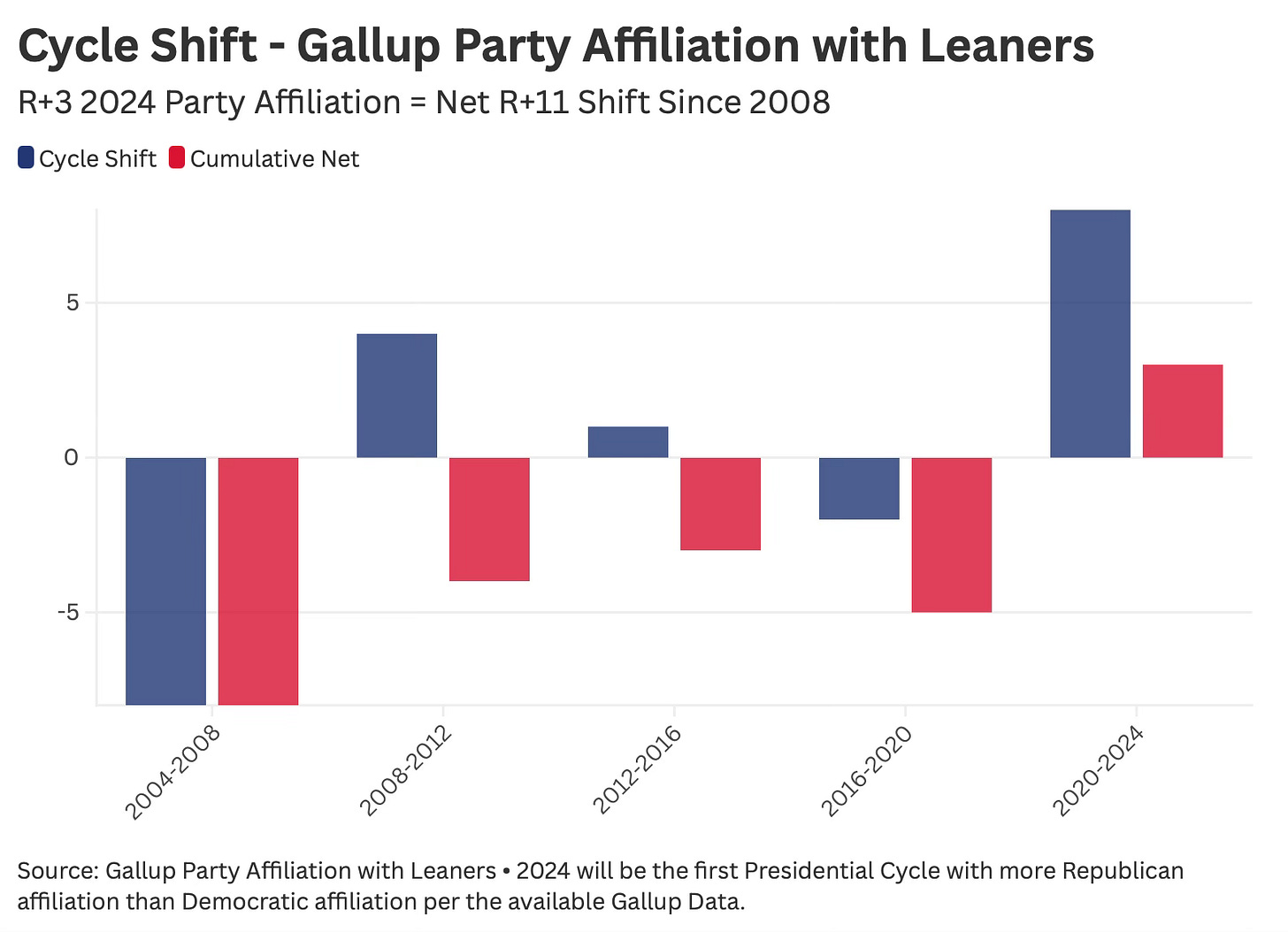The story nobody’s covering is that this presidential election cycle may be the first in history where the majority of partisans and independents lean towards Republicans.
Shift will determine the eventual 2024 election outcome, and 2024 is shaping up to be as impactful for Republicans as the 2008 electoral shift towards Democratic party affiliation according to Gallup’s data.
Shift is relative based on election cycles. The country has historically been Democratic in registration and self-identification. Unlike today’s hyper-partisan era, past Republican presidents built coalitions across party lines (think Dixiecrats, for example).
If the Gallup metric’s past performance maintains its bellwether status, the shift from 2020 to 2024 shows President Trump would win the national popular vote.
Gallup Party Affiliation Data
Gallup is a long-established polling agency with data going back further than is easily publicly available.
In September, they published results showing a R+3 electorate (3% more Republican than Democratic), which includes Independents who lean either way.
Based on freely accessible data, this is the first Presidential election cycle where there are more Republicans and Republican-leaning Independents than swing to Democratic affiliation.
Furthermore, the cycle shift from 2020 to 2024 equals the 2004 to 2008 cycle shift where Barack Obama capitalized on George W. Bush’s low approval ratings to sweep the election.
What Gallup data says is shocking - Trump has erased Obama’s 2008 surge in Democratic party affiliation.
The Numbers
Gallup’s metric is very strongly correlated to the national popular vote. Their R+3 metric represents an R+8 shift from the D+5 2020 electorate where Joe Biden won the national popular vote by 4.5 points.
If that metric translates into the actual electorate, it won’t be close.
2004 to 2008 saw a D+8 shift, driven both by George W Bush’s tanking approval ratings and the rise of Barack Obama’s campaign.
That gave Democrats a net positive advantage in the electorate which lasted for three more presidential election cycles, but this cycle’s shift has completely erased it.
This may be the single most important chart in understanding what will happen in 2024.
The blue bars represent cycle-over-cycle shift in Gallup’s party affiliation with leaners metric. The red represents the cumulative net impact of the Obama 2008 cycle.
For possibly the first time in American history, the electorate is going to identify more with Republicans than Democrats.
That puts the national popular vote in play.
Gallup posted their numbers on September 24. Trump took the lead in the national popular vote on October 26.
Going back to 2004, Gallup’s party affiliation metric is less than one percent higher than the national popular vote margin - that would look like a Trump +2 popular vote.
Does this translate to battleground states?
There are multiple data points that hint there will be a positive Republican shift in the battleground states.
First, our polling index shows that compared to 2020 there is party sample skew in favor of Democrats.
Second, registration trends have favored Republicans across the board. While it is true that, for example, in Pennsylvania we have seen positive registration trends in cycles where Republican nominees lost the state, the R+1 2020 electorate where Trump lagged with Independents is a thing of the past.
Last, search X/Twitter for early voting and absentee voting data. Even mainstream media are reporting that Republicans have increased their share in early voting and absentee ballots by more than double digits across the battlegrounds. Polling shows the majority of Democrats prefer to vote early versus Election Day, while the opposite is true for Republicans. If Republicans maintain their Election Day voting edge, the data certainly suggests the Gallup party affiliation trend shift is alive and real in the battlegrounds.
What this means for the polls
Polls either include weighting by party identification or they don’t.
Emerson is a great example of a poll where they are transparent and fairly consistently weight their surveys by both party identification to 2020 exit polls as well as weight the recalled 2020 vote.
The NY Times/Siena surveys are not weighted by sample. Their final Georgia poll showing Harris +1 was a net Harris +5 shift from their previous poll. Is that real momentum? No, because there was a 5-point increase in Democrats by party identification in their sample.
Weighting by party to the 2020 exit polls comes at a cost, though - is that what 2020 will look like?
Knowing there was a R+ shift in all 7 battlegrounds in 2020 and seeing Gallup’s R+8 shift in party affiliation with leaners from 2020 to 2024, everything is pointing to a strong electorate for President Trump’s historic bid to return to the White House.



